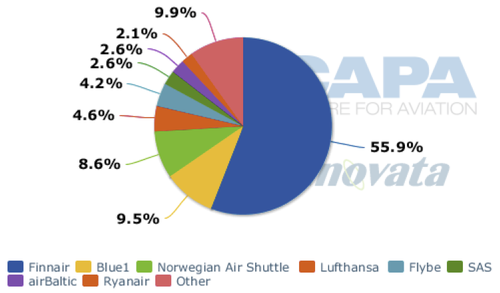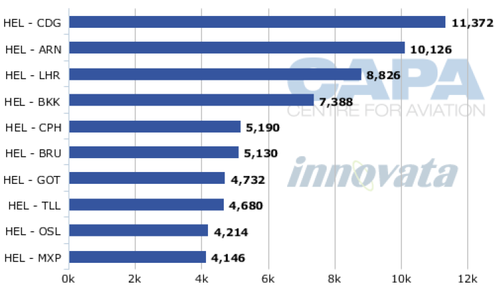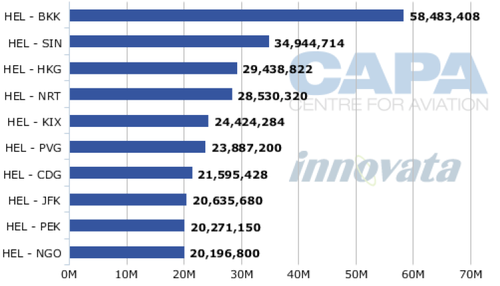Finnair to increase focus on Asia as JV partner takes over short-haul operation
Finnair has entered into discussions with potential partners to form a joint venture which would take over part of its unprofitable short-haul operation. The new JV would be a major component of a restructuring and could allow Finnair to increase its presence in the Nordic region under a lower and more competitive cost base. Finnair is seeking to use the new joint venture to open new bases in the region in line with its Nordic Champion strategy but has embarked on a restructuring of its own mainline operation to become competitive and restore profitability.
By establishing the JV, Finnair hopes to reduce costs on its regional network and free up capital to invest in further expanding its Asian network. The Europe-Asia market has been the major focus for Finnair in recent years with the carrier exploiting its geographic advantage to offer convenient connections to a growing number of Asian cities.
In announcing its 2011 results and revised strategy on 09-Feb-2012, Finnair CEO Mika Vehviläinen explained that "the potential joint venture would expand our home base to cover the entire Nordic region" and would "support our Asian strategy through increased feeder traffic for our Asian destinations and better presence in key cities throughout the Nordic region". Mr Vehviläinen said the arrangement is unlikely to include network carriers and should not require any equity tie-up.
An agreement is aimed to be signed in mid-2012, with the new joint venture operation expected to commence in 1H2013. Finland's Government, which owns a 55.8% stake in Finnair, has said it may consider selling its stake to enable the company to form a joint venture in Europe.
- Finnair is in discussions to form a joint venture to take over its unprofitable short-haul operation, allowing the airline to increase its presence in the Nordic region under a lower cost base.
- The joint venture would support Finnair's Asian strategy by increasing feeder traffic for its Asian destinations and providing a better presence in key cities throughout the Nordic region.
- Finnair is not in talks with other Scandinavian carriers such as Norwegian Air Shuttle or SAS, and it is also not considering Flybe Group as a potential partner.
- Rising fuel prices have severely impacted Finnair's finances, leading to an acceleration of its restructuring plans and a focus on cost reductions.
- The collapse of Malév Hungarian Airlines has left a void in oneworld's Central European coverage, potentially increasing reliance on Finnair as a transit hub between Western and Eastern Europe.
- Finnair's strategic location in Helsinki allows it to focus on expanding its Asian network, with plans to develop services to secondary cities in China and potentially India and Japan.
Flybe and Norwegian ruled out as potential new JV partners
Finnair stated it is not in talks with other Scandinavian carriers such as Norwegian Air Shuttle or SAS. Finnair has stated it is also not talking to the UK-based Flybe Group, with which it has an existing venture in Finland, Flybe Nordic. Flybe CEO Jim French recently stated the regional airline group is in discussions with a number of European carriers about operating regional European services for airlines who have found their short-haul networks to be unprofitable and who wish to concentrate on their long-haul operations.
Flybe Nordic, which is majority-owned by Flybe in a 60:40 split with Finnair was established in Jul-2011 following Flybe's acquisition of Finnish Commuter Airlines. It currently operates a fleet of 17 aircraft consisting of ATR 42s, ATR 72s and Embraer E170s across Scandinavia. It operates 11 domestic services in Finland, with its 12th, Helsinki-Kajaani to commence from 01-Mar-2012.
FlyBe Nordic currently ranks as the fourth largest domestic carrier in Finland, with a 13% domestic capacity share, behind Finnair, Norwegian Air Shuttle and Blue1. The airline has 4% of total capacity in the Finnish market.
Finnair accounts for 56% of Finland's overall capacity, increasing to 60% when the Flybe Nordic JV operation is included. Based at Helsinki-Vantaa Airport, Finnair holds 61% of the airport's system capacity and operates a mainly Airbus fleet with A319s, A320s, A321s, A330-300s and A340-400s forming the backbone of the airline's operation. The airline also operates Boeing 757-200s, E-170s and E-190s. Finnair also has 11 A350-900XWB aircraft on order, which it plans to use to expand its Asian network in the latter half of the decade.
Finland capacity by carrier (% of seats): 20-Feb-2012 to 26-Feb-2012
Rising fuel prices severely impacting Finnair's finances
Finnair's decision to seek a second joint venture partner in the short-haul market comes after a disappointing financial performance in 2011. Finnair reported a group revenue increase of 11.6% in 2011 but operating costs exceeded this growth with a 13.9% increase year-on-year. As a result, the airline recorded a net loss of EUR87.5 million for the year, compared to a EUR22.8 million loss the previous year.
Expenses are expected to increase even higher in 2012 mainly due to fuel costs. Rising fuel prices are already severely impacting Finnair, with the airline's fuel expense in 2011 rising 28.6% year-on-year.
The current financial situation along with growing competition in the Nordic region and uncertainty in the European economy has led to an acceleration of Finnair's restructuring plans. The airline now expects to make cost reductions of EUR80 million in 2012, most of which will be achieved in 2H2012. The restructuring programme is aiming at reducing costs by EUR140 million annually.
See related article: Finnair earnings deteriorate as restructuring efforts ramp up
The new JV will provide efficient links from Europe to Helsinki, feeding onto Finnair's long-haul network. With a low-cost rather than network carrier expected to emerge as Finnair's new partner, the JV should give Finnair a larger presence in the market while being a cost-effective operation.
Finnair will need to tread carefully in setting up the new joint venture operation to avoid any negative impact on its long-haul network. To ensure long-haul passengers are not deterred from travelling via Helsinki because of the low-cost short-haul link, Finnair will need to consider making sure the operation falls under oneworld and includes an optional level of service which can be customised for those connecting to long-haul services. This could include complimentary check-in baggage for passengers connecting onto long-haul services while point-to-point passengers may be charged baggage fees. Middle seats could also be blocked for long-haul premium passengers.
Through bundling the airline's short-haul product, a low-cost approach could be achieved while still providing long-haul passengers full service. The short flight times within Europe should allow Finnair to pursue such a strategy without significantly impacting its existing long-haul premium business. In fact, demand for Finnair's long-haul product could increase as the new joint venture will allow the carrier to serve more short-haul destinations than it can viably with its own metal.
Helsinki hub could benefit from Malév collapse
The recent collapse of Malév Hungarian Airlines has left a void in oneworld's Central European coverage, with the loss of Malév's Budapest hub. oneworld's only remaining Eastern European carrier is now S7 Airlines, based at Moscow Domodedovo. This may see oneworld partners rely more upon Finnair in Helsinki as a transit hub between Western and Eastern Europe. Finnair's new JV short-haul network could help fill the void left by Malév through providing a larger number of Central and Eastern European links, under the oneworld network.
The short-haul joint venture could potentially become an affiliate of oneworld rather than a full member. For example, British Airways' two franchise partners are now oneworld affiliates - Sun Air of Denmark and Comair of South Africa. British Airways does not own Sun Air and only owns 18% of Comair through parent International Consolidated Airlines Group (IAG).
Flybe Nordic currently does not come under oneworld affiliate membership. But is also a potential option for the carrier considering Finnair's 40% ownership.
Growing Asian network
Finnair's base at Helsinki is strategically located for services to Asia, with much of the airline's Asian branding highlighting its Asian routes as having the quickest services and smoothest connections from Europe. The airline has a small home market and therefore relies greatly upon its short-haul connections to Europe to feed into its growing Asian network.
Finnair currently offers just under 100,000 seats per week across its Western European network, feeding through its Helsinki hub. Its second largest market is Northeast Asia. Southeast Asia ranks fourth. In total, Finnair offers 33,892 seats per week to Asia.
Finnair international capacity (seats) by region: 20-Feb-2012 to 26-Feb-2012
In the early part of last decade, Finnair chose to focus on Asia over Europe and America, taking advantage of its positioning in northern Europe. The airline now serves 11 destinations in Asia with Bangkok, Beijing, Delhi, Hong Kong, Nagoya, Osaka, Seoul, Shanghai, Singapore, Seoul and Tokyo all served from Helsinki. In May-2012 the airline will launch its 12th route to Asia - Chongqing. Finnair has also recently offered winter charter services from Helsinki to Langkawi in Malaysia. From its destination airports in Asia, Finnair offers connecting services throughout the region with fellow oneworld members such as Japan Airlines (JAL), Cathay Pacific and Qantas.
Finnair's Asian network has expanded rapidly in recent years, with Delhi service launched in Jan-2011 and Singapore added in May-2011. Singapore is providing Finnair a base to access many offline markets in Southeast Asia such as Malaysia and Indonesia. Last year, frequency also increased on some of Finnair's Asian routes including Seoul Incheon and Hong Kong.
Finnair has shown interest in expanding services to existing Asian markets, particularly China, India and Japan. In Sep-2011 Finnair director Indian sub-continent Kari Stolbow stated India was a "priority destination" for the carrier with Mumbai, Bangalore, Chennai and Hyderabad under consideration. In Nov-2011 Finnair stated it had been seeing load factors averaging 90% on its services to Japan and said it would be interested in launching daytime services to Tokyo Haneda if the slots were made available.
Bangkok is Finnair's top Asian route, ranking fourth for its total number of seats offered per week across the airline's entire international network.
Finnair top 10 international routes by seats: 20-Feb-2012 to 26-Feb-2012
Based on ASKs, Finnair's top six international routes are to Asia, with a further two ranking ninth and 10th. The only other long-haul international route that makes it into the top 10 is New York JFK at eighth. This is the airline's only North American service.
Finnair top 10 international routes by ASKs: 13-Feb-2012 to 19-Feb-2012
Finnair is now looking further into developing its Chinese network beyond primary airports such as Beijing and Shanghai. Due to the huge population in China, secondary cities are still incredibly large markets with huge potential, especially with growing trade links between China and the rest of the world. The Chongqing area currently has approximately 28.8 million people compared with Helsinki at 589,000 or London on 7.8 million. Earlier this month, Finnair opened an office in Chongqing as it prepares to launch services to the Chinese city.
Once it commences operations from Chongqing, Finnair will be the only carrier from Europe serving the city. Qatar Airways is the only other carrier not from Asia that also serves the city. With the limited competition, Chongqing could become a very successful route for the carrier. Other secondary cities in China such as Xiamen and Chengdu could also prove attractive to Finnair, with KLM the only European operator to Xiamen and Etihad as the only non-Asian carrier into Chengdu.
Currently, Finnair's Asian network has an advantage because Finland is not served by any Gulf carriers. But this is set to change later in 2012 with Qatar Airways planning to commence Doha-Helsinki services. This move could potentially have a large impact on Finnair as Qatar also has an extensive Asian network. However, Finnair will still have an edge over such Gulf Carriers, with its 'quick' service between European and Asian cities still generally faster than travelling via the Middle East to Asia.
Limited direct long-haul competition
Finnair is the sole operator on all its Asian routes although oneworld partner Japan Airlines will operate alongside Finnair in the Tokyo-Helsinki route starting next year. Finnair will codeshare on the new JAL service.
Finnair is actively encouraging other oneworld carriers to launch long-haul services to Helsinki to help boost the position of its hub. For example, future oneworld member Malaysia Airlines has been asked to consider launching services to Helsinki from Kuala Lumpur, a route Finnair currently does not serve. Among current and future oneworld members, only British Airways and airberlin now serve Helsinki.
Finnair's main competition on its Asian network is from SAS Scandinavian Airlines and SAS' Star Alliance partners in the Asian market. SAS offers services to Bangkok, Beijing and Tokyo Narita from its Copenhagen hub. While in itself SAS does not offer an extensive Asian network, Star Alliance members Singapore Airlines, Thai Airways and Air China also offer direct services from Scandinavia to Asia.
SAS also recently announced network changes at subsidiary Blue1 which will see it become more of a feeder from Finland into SAS' key Stockholm and Copenhagen hubs. This will increase the level of competition for Finnair with SAS attracting travellers from regional areas in Finland to travel long haul with SAS through Copenhagen instead of via Helsinki with Finnair.
As SAS only offers three Asian routes compared to Finnair's 11, Finnair is in a strong position to serve the overall Scandinavia-Asia market. Finnair currently does not have an extensive intra-Scandinavian network, only serving four cities across Sweden, Denmark and Norway from Helsinki. But it is aiming to address this with its short-haul joint venture plans, which will see it increase its presence within the Scandinavian region. Flybe Nordic also already provides Finnair some feeder traffic from Scandinavia.
See related article: Blue1 to become feeder for SAS' Copenhagen and Stockholm hubs in move against Finnair and Norwegian
Finnair potentially faces long-haul competition from the low-cost carrier Norwegian Air Shuttle. Norwegian recently announced plans to base its first 787 in Asia and operate the aircraft to Europe starting in early 2013.
Through its restructuring programme and cost reduction strategies, Finnair is aiming to turn its loss-making short-haul operation around. This should allow Finnair to further invest in its Asian network, with the overall aim of becoming one of the top three network airlines between Europe and Asia. The proposed joint venture on short-haul services will allow Finnair to reduce its costs on its critical European network and to more effectively and efficiently provide feeder traffic through Helsinki onto its Asian network. These moves are important to make now as market conditions become more challenging and new competition with Gulf carriers loom.

 Finnair.png" alt="" />
Finnair.png" alt="" />

